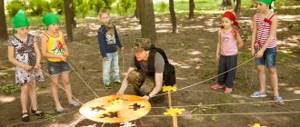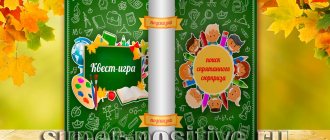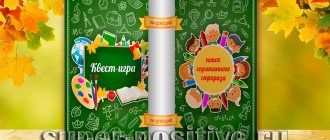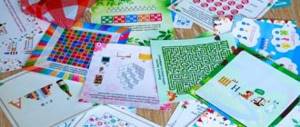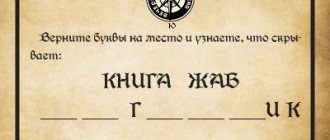Why do you need an educational webquest?
- Developing interest in studying the subject.
- Identifying students who are interested in the subject.
- Improving results through a competitive format.
- Developing the ability to work and make decisions in a team.
- Development of strong-willed and leadership qualities of students.
- Obtaining and improving skills in using educational applications and services.
- Encouraging the use of electronic devices by schoolchildren for educational purposes.
Main stages of the educational quest
- Development of the quest, preparation of materials.
- Introduction to the plot, formation of teams, distribution of roles.
- Completing tasks, solving problems, passing stages.
- Summing up, awarding the winners.
- Analysis of results, subsequent pedagogical actions depending on the goal and result.
Quest lesson: equipment and online resources
- Computer/laptop + tablet/smartphone
- Internet connection
- Quizizz (website and application for working with quizzes)
- Google Forms (a universal service for creating tests, surveys, etc.)
- Google Sites (website builder)
- QR code generator (for example, QRCoder.ru)
- Application for reading QR codes (for example, “QR-reader” or standard “Camera”)
Quest is a game for students in grades 5-8. Abstract
The quest game “School Time” is intended for students in grades 5-8.
Explanatory note The history of the first school in the city of Komsomolsk-on-Amur is inextricably linked with the history of the city itself. On November 2, 1932, the first city school opened in an ordinary village hut. A.M. becomes the first director and teacher. Grachev, famous Far Eastern writer. In November 2021, the first school in the city of Komsomolsk-on-Amur celebrated its 85th anniversary. The quest “School Time” is dedicated to this anniversary. The quest was developed and conducted by 6th grade students, since working with teenagers is significantly different from working with primary schoolchildren. Teenagers are increasingly striving for freedom and independence from the influences and authority of adults. Adolescents' activities change their self-perception, which in turn also affects their behavior and well-being. Teenagers need to feel important; they assert themselves. The main task of the teacher is to form and support a creative approach to activities in adolescents. We decided to hold a game in the form of a quest for middle school students, so that the children would once again learn the history of their home school in a playful way, visit different parts of it, and carefully examine its features. Goal : to attract the attention of students of Municipal Educational Institution Gymnasium No. 1 to the history, features, events, and attractions of their school. Objectives: - remind students of the history, features and important events of the school in which they study through quests; — create conditions for the development of team play, where one for all and all for one; — to cultivate the patriotic qualities of students through completing quests related to the history and characteristics of their home school. The quest was developed and conducted by students of the 6th grade of gymnasium No. 1 under the guidance of the additional education teacher of the Children's Technopark "Quantorium" Gorelova E. V. Age category : the quest was conducted among students of grades 5-8 in two age categories - grades 5-6 and grades 7-8 . Team of 5-6 people per class. The quest tasks of this quest can be taken as a basis and carried out in any school in the city. Quest duration : 1.5 – 2 hours (with opening and rewarding). Features of the quest : the quest consists of 10 stations, named after school subjects. The quest was designed in such a way that the teams themselves looked for answers to the tasks, having carefully read them in the route sheets. Only at some stations there were observers to monitor the safety of the office equipment, but they did not help the teams in any way. Quest rules: at the beginning of the quest, the teams are given a balloon containing a rebus (Appendix 1). The team's task is to inflate the balloon so that it bursts, take out the rebus, and guess it. The answer to the rebus is the keyword of a station. Tell the presenter the answer and the station the team is going to run to. Having completed the task at the first station, the teams move further clockwise from station to station. Having completed the route, the teams find a leader. They hand over the route sheet to him and receive a photograph of the place where their prize is hidden (you can pack sweets or a chocolate bar per team and hide them, for example, in the director’s or vice-principal’s office). While the teams are looking for their sweet prize and eating it, the quest organizers count the points on the route sheets and sign the diplomas. After all teams complete the quest route, the winners and runners-up among grades 5-6 and 7-8 will be awarded separately. Equipment and design of the quest No special equipment is needed to conduct the quest. Posters, stands, and museum exhibits from the school are used. In one of the classrooms you need to turn on the projector and computer. A description of the equipment for each of the stations can be found in the “Description of Stations” section. Methodological recommendations and tips for the preparatory period Preparing a quest is a long and creative process. Initially, it was necessary to come up with the name of the stations and tasks for them, but not just simple ones, but quest tasks, so that the quest participants would independently look for answers to these tasks. We determined the number of stations based on the number of school subjects. Then, we divided the stations among the children and each group used the method of “brainstorming” and “running around the school” to look for questions and riddles in the corridors, offices, and on school shifts. This stage took the longest time. After determining the tasks for the stations, there was a stage of preparing the didactic material. At the stage of preparing the quest, the head of the creative group must coordinate the holding of the game with the school administration, notify the class teachers and children about the game, print out the regulations about the event and hang it on the notice board and in the classrooms. In addition, at one station we needed the help of a specialist in 3D pens and we invited him. At the preparatory stage, it is necessary to print out diplomas and thanks to the quest participants and thanks to the guys from the creative group, as well as to the specialists helping at the stations. Methodological recommendations and advice on the location and conditions of the event, on design options, on the conditions for creating an emotional mood. The “School Time” quest can be carried out in any school, if some stations are adapted to the characteristics of that school. Designing this quest is not a labor-intensive process, because the equipment of the school’s corridors, classrooms, and library is used. Only at some stations it is necessary to prepare an office (a description of station preparation can be found in the “Description of stations” section). Before the start of the quest, all teams gather in the assembly hall, songs about the school are played, and balloons are hung throughout the hall, under which chairs are placed for each team. Each team chooses the color of the balloon and sits under it, coming up with a name and emblem (this task is given in advance). Scenario plan 1. Opening of the event (5-7 minutes). 2. Teams work on quest tasks (1-1.5 hours). 3. Summing up, rewarding (5-7 minutes). Progress of the event General gathering of teams in the school assembly hall, registration. Introductory word by the presenter: a poem is read out: You were born along with the city And you entered its history, In the times of heroic ligature... I won’t hide how proud I am of you! From the avenue where the school stands, crowned with its good glory, a thread of memory stretches to the log hut. The cramped house made of resinous foliage was unprepossessing and simple in appearance. But he seemed higher than the stars to those guys with pure souls. And a remote corner of the taiga Suddenly a cheerful bell woke me up... This means the first lesson Begins at the first school
The rules of the quest are explained.
Route sheets are distributed (Appendix 2) and the teams scatter to their first stations. The teams then go from station to station clockwise. Description of MATHEMATICAL stations Venue: 4th floor Materials and equipment: stands on the 4th floor. Assignment: by writing the answers to the questions, you will find out how old our school will be in 2021. - the number of buildings in which the school was located ______ (4) - the number of school directors throughout its history ______ (13) - the number of first teachers _____ (10) - the number of honored teachers of the school _____ (4) - the number of veterans of teaching, excellent students of public education ____(26) - the number of graduates of 1942 who went to the front in full force ______ (11) - the number of graduates who graduated from school in 1954 in the current school building _(20) Answer: 88 years. Points: for each correct answer 1 point. Maximum number of points – 7 Password: task Responsible: independently RUSSIAN SPEAKING Venue: 2nd floor Materials and equipment: stands on the 2nd floor. Assignment: somewhere on the second floor is hidden the name of a children's organization operating in our school since 2002. Any school student aged 8 to 17 years old can join it at his own request. Write its name correctly and decipher it. Answer: VeGaYun - Great Galaxy of the Young. Points: 1 Password: Russia Responsible: independently. FOREIGN LANGUAGE Venue: foreign language classroom. Materials and equipment: chalkboard with text, keyboard. Assignment: on the board in room 22 the text is written in English letters, but on the Russian keyboard layout KBYUDBCNBRF – YFERF J ZPSRF[. The team needs to guess where to find the key to the cipher (keyboard on the table) and decipher the text. Answer: Linguistics is the science of languages. Points: 1 Password: London. Responsible: Violetta G. LITERARY Venue: library. Materials and equipment: no. Assignment: compose a syncwine on the theme of the school’s anniversary. A cinquain is a creative work that takes the short form of a poem consisting of five unrhymed lines. Sinkwine is written according to the following rules: 1 line – one noun expressing the main theme of syncwine. Line 2 – two adjectives expressing the main idea. Line 3 – three verbs describing actions within the topic. Line 4 is a phrase that carries a certain meaning. Line 5 – conclusion in the form of a noun (association with the first word). Answer: Points: from 1-5 Password: author. Responsible: Alena M. CREATIVE Venue: office 12. Materials and equipment: multimedia projector, presentation with photographs (Appendix 3). Assignment: working with photographs of the school. 6 photos of school nooks and crannies you need to know. Answers: Points: 1-6 Password: pencil. Responsible: Ekaterina Sh. CHEMICAL Venue: chemistry classroom Materials and equipment: numbers glued to desks, tape. Numbers corresponding to chemical elements in the periodic table are attached to tables in the classroom. Teams need to guess that the numbers are the atomic numbers of chemical elements and if they are written out, the first letters will form the word - REACTION. Element numbers: 80 – Mercury 63 – Europium 7 – Nitrogen 27 – Cobalt 40 – Zirconium 49 – Indium I Assignment: The periodic table hangs on the wall in the chemistry classroom. This table contains all the chemical elements known to mankind that make up the Earth and the entire Universe. The word is stored in numbers, you can guess it, and find out the chemist’s treasured word. The table and capital letters will help you, but you will find the numbers by looking around. Password: gold. Responsible: Elena B. HISTORICAL Venue: school museum. Materials and equipment: museum exhibits. Assignment: find the answer to the riddle among the museum exhibits and write it down. The red reminder remained for a century. It was lost on the destroyed wall. Answer: “I’m dying, but I’m not giving up.” Points: 1 Password: victory. Responsible: Vorobyova A. PHYSICAL Venue: physics classroom. Materials and equipment: three faceted glasses (take from the canteen), a sheet of A4 paper (one per team). Assignment: there are two glasses on the table at a distance of 15-20 cm from each other. There is an A4 sheet that needs to be placed on these two glasses and a third glass (between two) placed on top of it so that the sheet does not bend to the table. Time for task 5 minutes. Answers: the sheet needs to be folded like an accordion, then the glass will stand. Points: 1 point for completed task Password: mass Responsible: Veronica K. BIOLOGICAL Location: somewhere in the school. Materials and equipment: no. Assignment: find animals at school and write them Answers: Himalayan bear, Amur tiger... Points: 1-5 Password: frog. Responsible: independently. GEOGRAPHIC Venue: geography classroom Materials and equipment: pictures of geographical objects - Solar system, planet Earth, continental Eurasia, country Russia, Far East, Khabarovsk Territory, city of Komsomolsk-on-Amur, Lenin Avenue, gymnasium No. 1 Assignment: on the board in Pictures of geographical objects are attached to the office. Teams must put them in a certain order in order to get from space to the geography classroom. Answer: Solar system - planet Earth - mainland Eurasia - country Russia - Far East - Khabarovsk Territory - city of Komsomolsk-on-Amur - Lenin Avenue - gymnasium No. 1 - 4th floor - geography room (the team must complete the last two objects). Points: 1 + 1 (if the team wrote “4th floor-geography office”). Password: Baikal. Responsible: Danila N. TECHNOLOGICAL Venue: technology room. Materials and equipment: 3D pen, inscription stencil CONGRATULATIONS TO YOUR FAVORITE SCHOOL ON THE 85TH ANNIVERSARY! Assignment: Using a 3D pen, each team writes a congratulation on a stencil. How many people are on the team, the number of letters they write. Working time per team is 5 minutes. This pen is not a simple one. It cannot be written in a notebook. With this pen, you guys congratulate your native school! Points: 1-5 (depending on how many letters the team manages to write). Password: gadget. Responsible: Ekaterina Anatolyevna Cheverda, teacher MBOU DO Quantorium SPORTS Venue: somewhere in the school. Materials and equipment: no. Assignment: running up the school stairs is a favorite activity of students. Count the number of steps from the first to the fourth floor on both sides and write the answer. Answer: steps. Points: 1 point. Password: shooting. Responsible: independently Methodological tips for summing up. Summing up the results of the quest is held in the assembly hall. Teams from grades 5-6 and grades 7-8 are awarded separately. You can award one first, several second and several third places based on the number of points scored. Don't regret your diplomas! Conclusion The “School Time” quest, dedicated to the 85th anniversary of the Municipal Educational Institution Gymnasium No. 1 of the city of Komsomolsk-on-Amur, was held on October 27, 2021 among school students in grades 5-8. In total, 8 teams of 5-6 people took part in the quest. The set goals and objectives of the quest were completed. After the quest, the guys came up and shared the features they saw in their home school, although they have been studying there for more than 6 years. The quest tasks were structured in such a way that the students looked into all corners of their home school, read the information on the stands again, and visited the school museum (photo report in Appendix 6). Preparing a quest is a labor-intensive but interesting activity. It is necessary to make sure that the children independently learn to read tasks, understand them and carry them out, and not like in the station game, when the team runs to the station, the task is read to them, everything is explained and the team completes it. The “School Time” quest was prepared with sixth grade students. This is a good way to motivate middle and senior level students to participate in our associations. The guys feel important. And after the game, the organizers must give thanks for preparing the quest. References 1. Giniyatullina A.A. Experience in organizing group work in the classroom. /A.A. Giniyatullina // Primary school. – 2004. – No. 1. – pp. 15-17. 2.Grachev, A.M. First clearing / A.M. Grachev. – M.: “Young Guard”. – 1972. 3. Zhukov, Yu. A. First Builders: A Documentary Story / Yu.A. Zhukov, R.N. Izmailova. – M.: Young Guard. – 1982. – 303 p. – ill. – photogr. — (Anthology of Komsomol construction projects). 4. Kostaeva T.V. On the issue of studying the sustainable cognitive interest of students - KARO, 2004. - 45 p. 5. Website of Municipal Educational Institution Gymnasium No. 1 - https://www.kna-s1.ru Appendix 1 Puzzles for starting the quest (find puzzles on the Internet). FROG, GOLD, TASK, RUSSIA, MASS, BAIKAL, VICTORY, PENCIL, LONDON, AUTHOR, GADGET, SHOOTING Appendix 2 ROUTE SHEET We are glad to welcome you to the “School Time” quest, dedicated to the 85th anniversary of gymnasium No. 1 Task 1. Inflate the air the ball until it bursts. You will find a rebus in the ball - this is your first station. Next, you must move from your first station to the next station clockwise. At the stations, you yourself complete the tasks written on the route sheet and enter your answers into it, or an observer at the station checks your answer. Upon completion of the quest and completion of all tasks, you give the route sheet to Elena Valerievna and receive a photo of the place where your prize is hidden! The winners of the quest are determined in two age groups: 5-6 and 7-8 grades, based on the sum of points for all tasks. The winners will be awarded at the line at the end of the quarter. Good luck! MATHEMATICAL Assignment: by writing the answers to the questions, you will find out how old our school will be in 2021. - the number of buildings in which the school was located ______ - the number of directors of the school throughout its history ______ - the number of first teachers _____ - the number of honored teachers of the school _____ - the number of veterans of teaching, excellent students of public education ______ - the number of graduates of 1942 who went to work in full front ______ - the number of graduates who graduated from school in 1954 in the current school building _____ RUSSIAN SPEAKING Assignment: somewhere on the second floor the name of a children's organization operating in our school since 2002 is hidden. Any school student aged 8 to 17 years old can join it at his own request. Write its name correctly and decipher it. Answer: _____________________________________________________________________ FOREIGN LANGUAGE Assignment: decipher the text written on the board. Answer: _______________________________________________________________________ HISTORICAL Assignment: find the answer to the riddle among the museum exhibits and write it: The red reminder remained forever On the destroyed wall, it was lost. Answer: _______________________________________________________________________ LITERARY Assignment: compose a syncwine for the school’s anniversary. Sinkwin is a creative work that has a short form of a poem consisting of five non -rhythmic lines. Sinkwin is written according to the following rules: 1 line - one noun expressing the main theme of sinkwin. 2 line - two adjectives expressing the main idea. 3 line - three verbs describing actions within the topic. 4 line - a phrase that carries a certain meaning. 5 line - conclusion in the form of a noun (association with the first word). Answer: Sinkwin on the topic “________________________________” 1 line ________________________________________________________________ 2 line ______________________________________________________________________________________________________________________________________________________________ ____________________ ( This table contains all the chemical elements known to mankind, of which the Earth consists and the whole universe. Task: The word is stored in numbers, you guess it, and find out the cherished word of the chemist. A table and title letters will help you, but you will find numbers by looking around you. Answer: ___________________________________________ Physical task: on the table you see two glasses and a sheet of paper. Put a sheet of paper on these two glasses so that put a third glass on top of it and that a sheet of paper does not bother to the table. Time for a task 5 minutes. Biological task: find animals at the school and list them. Answer: __________________________________________________________________ The geographical task: make a route from the solar system to the geography cabinet using geographical objects. Answer: ________________________________________________________________________ ____________________________________________________________________________________________________________________________________________________________ ___________________________________________________________ technological pen is not simple, it can not be written in a notebook. Congratulations to this pen of your own school! Sports task: running around the stairs of the school is a favorite occupation of students. Calculate the number of steps from the first to the fourth floor on both sides and write the answer. Answer: _______ steps. Appendix 3 photos for a creative station (you need to increase and print or insert a photo of the school natives) Appendix 4 digits for the chemical station (you need to increase and print) 8o, 7, 40, 49, 27, 63, I Appendix 5 Objects for the Geographical Station (you need to find pictures on the Internet and print) Solar system planet Earth Earth Earth Eurasia Country of the Far East Khabarovsk Territory Coaters of the Komsomolsky district coat of arms of Komsomolsk-on-Amur Prospekt Lenin Gymnasium No. 1 Appendix 6 Photo report on the conduct of the Office “School Time”
We recommend watching:
Scenario of a game program for schoolchildren in grades 8-11 “IT marathon” Game “Lucky Accident” for students in grade 6 Game “National costumes of different nations” for schoolchildren in grades 5-9. Abstract
Similar articles:
Game programs for school-age children. Scenarios
What kinds of quest games are there for children?
Since a quest is a game using logic, ingenuity, intelligence, attention and broadening one’s horizons, the tasks in the game are aimed at developing these qualities:
- The most favorite type of riddles for children and parents is encryption. There is no better way to feel like a real detective or spy than decryption! The main thing is not to forget to attach an encryption key to the hidden word. This and other tasks can simply be drawn on a piece of paper with felt-tip pens; artistic skills do not matter here. You can find different ciphers on the Internet or come up with it yourself. Here are some examples of ciphers:
- according to the first letters of the drawings (pillow - P, sun - S, etc.);
- according to conventional signs (letters can be denoted by any icons, crosses, lines, circles, etc., and their sequence can be composed);
- in existing other languages (replace Russian letters with English ones located on the same keyboard keys, Braille for the blind, Morse code or sign language);
- “dancing men” from “The Adventures of Sherlock Holmes”;
- move the letters one step forward (when instead of A we write B, instead of G – D, etc.) or two steps back (instead of A we write Y, and instead of G – B).
- Rebuses: you can come up with and draw them yourself or create a ready-made rebus on the Internet (type “rebus generator” in the search). Just make sure your child knows the rules for solving puzzles or write short instructions.
- Crosswords and any tasks in which you need to write words in the cells and read the answer from the cells highlighted in a different color. For example, such a task is in our quest envelope “Finding a Gift”.
- Riddles: from the Internet or invented by yourself. It is better to use not a well-known riddle (such as “a pear is hanging - you can’t eat it”), but an original, more complicated one: “the house is a glass bubble, but a light lives in it.” It is this riddle that is encrypted in one of the cards of the quest “The Secret of the Hieroglyph.”
- Description of the item: in your own words or the whole definition from the dictionary. “A device that maintains a low temperature in a thermally insulated chamber, used for storing food or items that require storage in a cool place” - you might not immediately guess that this is a refrigerator!
- Puzzle: draw a picture of the next hiding place or write a riddle and cut the piece of paper. You can understand what is in the picture only after putting the parts together.
- Mathematical tasks: count the number of steps up to the 1st floor and tell the resulting number to your assistant-accomplice, who, in exchange for the correct answer, will tell you where to look next. Add up the number of legs for all the furniture in the room and look for a card in the mailbox with that number. Divide the apartment number by 4 and ask a relative with that date of birth for a hint.
- Logical letter tasks:
- cross out the letters that are repeated on the sheet, and make up an answer from the remaining ones;
- read the answer based on the first letters of the poem;
- cross out certain words from the letter grid and assemble the answer from the remaining letters. For example, in the “Transport” task, you need to cross out the names of modes of transport from the pictures from the quest envelope.
- Search quests: In addition to finding each next clue, some quests may require you to find several notes, items, or any artifacts in a given room. For example, in the quest “The Case of the Stolen Cake,” children must improve their detective skills in finding “bugs” and find 20 hidden pictures with bugs in the room. There are letters written on the back of some bugs. Yeah, you need to make a word out of them - this is a new hiding place!
And in the “Woof-Woof Team” quest for kids, children look for lost bones. It's a lot of fun and there's sure to be something for everyone involved! When the company is large, you can increase the number of items that need to be collected.
Sometimes the quest uses not only tasks on cards, but also games that are conducted by an adult (and if there are a large number of children in a company or at school, this is necessary). They are aimed at mutual assistance, teamwork, communication and the development of creative abilities.
10. Active tasks:
- relay races: in the “Superhero Quest” there is a game “Rescuers” - the leader lines up all the children in 1, 2 or 3 lines one after another on one side of the site, on the other he puts any toys according to the number of children (you can put them in one box, you can put them in different places), these toys need to be saved as soon as possible, taken to a safe place. Along the way, you can arrange an obstacle course that is adequate in complexity to the children’s abilities;
- ball games (believe it or not, dodgeball - the one who stays in the game the longest will get a hint);
- games with props: with a rope - tie a weight to the end of the rope and move it under the feet of the children who stand in a circle; whoever gets hit is eliminated. With different clothes - pass and put on hats at speed, or be the fastest to put on as many clothes as possible from the pile. With balloons - divide all the players into two teams, lay a rope on the floor between them, each team is only in its own half. You need to throw balls of your color to half of your opponents, and throw away their balls and yours. At the signal of an adult, the game stops and which team has more of its own balls in the opponent’s half and fewer of others’ balls in its own are the winners.
11. For attention and memory: remember the objects in a certain sequence lying in front of the presenter, and then lay out from memory how everything happened. Collective counting in a circle with the omission of some numbers (for example, we count only even numbers or skip those where a unit is used, or skip all numbers divisible by three, etc.).
12. Creative tasks:
- a collective drawing on the theme of the quest or filling out a poster with wishes for the birthday person;
- a small master class on making, for example, bookmarks or (as in the quest “The Secret of the Hieroglyph”) fans.
- dance competition (rap battle, dances of different nations to the appropriate music or the most energetic dance);
- theatrical mini-production (with very serious faces and play “Turnip” to the storyteller’s speech, using costumes from scrap materials).
